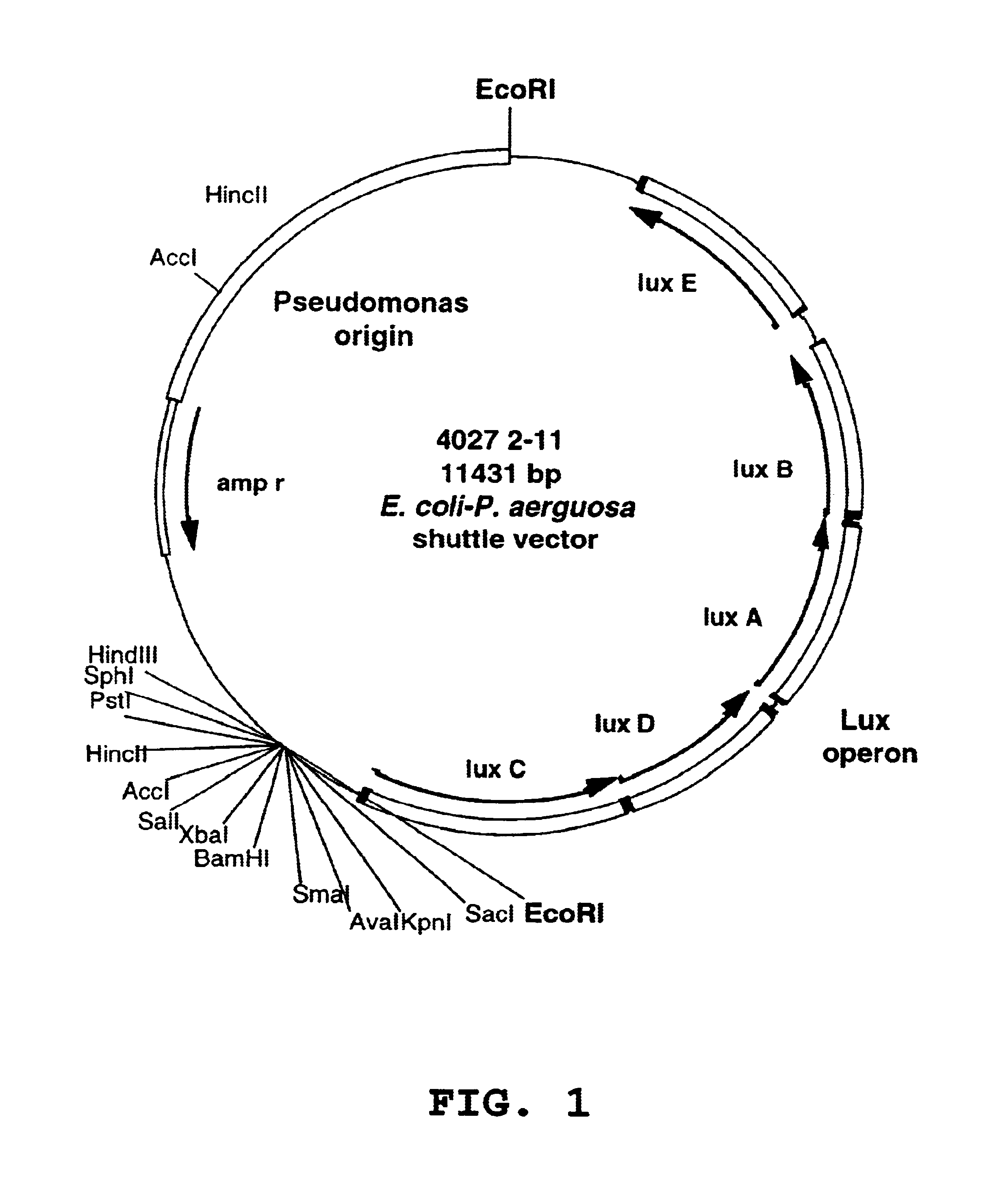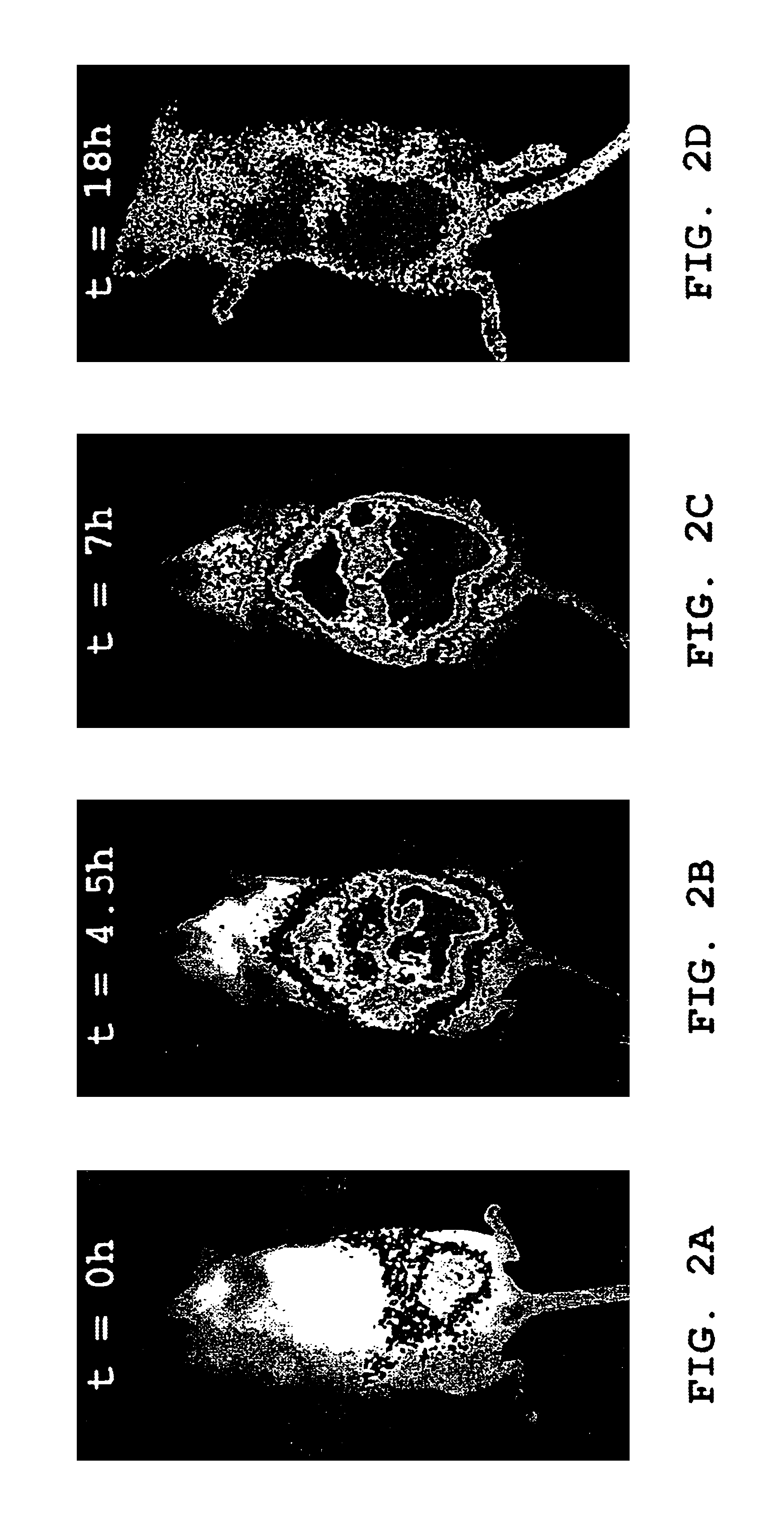Animal models and methods for sepsis
a sepsis and animal model technology, applied in the field of animal models of sepsis, can solve the problems of death as an endpoint model, study takes longer than, and substantial amount of money and time gon
- Summary
- Abstract
- Description
- Claims
- Application Information
AI Technical Summary
Benefits of technology
Problems solved by technology
Method used
Image
Examples
example 1
Development of Septicemia
[0129]Female Balb / c mice (10-12 weeks old), anesthetized as described above, were injected intraperitoneally (i.p.) with 1×106 luminescent 2-11 lux P. aeruginosa bacteria suspended in a total volume of 0.25 ml, and imaged at selected times as described above. Exemplary images are shown in FIGS. 2A, 2B, 2C and 2D. FIGS. 2A, 2B and 2C are images from one of the mice, taken at t=0, 4.5 and 7 hours, respectively. FIG. 2D is an image of another (similarly-infected) mouse taken at 18 hours. The relative intensity of photon counts is shown in pseudocolor in both images, and is superimposed over a grayscale reflected light image of the mouse in FIGS. 2A, 2B and 2C.
example 2
Signal Increase with Time in Mice Infected with 2-11 lux
[0130]Six female Balb / c mice (8-12 weeks old), anesthetized as described above, were injected i.p. with 2-11 lux P. aeruginosa as described above. The doses were selected to fall in the same order of magnitude as the range of LD50 values from previous studies with this species. Mice 1 and 2 received 1×106 bacteria, mice 3 and 4 received 5×105 bacteria, and mice 5 and 6 received 1×105 bacteria. The luminescent signal in each mouse was imaged in vivo at 0, 6, 12, and 24 hours post-infection and quantified as relative number of photons per pixel. The data are summarized in Table 1, below, and graphed in FIG. 3.
[0131]
TABLE 1MouseMouseMouseMouseMouseMouseTime (h)12345600.3090.3620.3490.2710.2820.23860.4460.6931.1701.1300.3280.198120.4182.8100.3350.3740.2330.185246.380118.600.4640.8660.3190.220
[0132]FIG. 3 shows the signal, in average number of photons per pixel, for the 6 mice, at 6, 12 and 24 hours. It can be appreciated from the d...
example 3
Death Expectation Curve
[0133]The mice described in Example 2 were monitored for 55 hours. Mice 1, 2, and 4 died during the course of the experiment, whereas mice 3, 5, and 6 were able to clear the infection. Based on the data in FIG. 3 and Table 1, above, the onset of terminal sepsis for this experiment was determined to be between 12 and 24 hours post-infection. The 24 hour time point was selected as a convenient point in time after the onset of terminal sepsis, but before the death of the animals, for use in constructing death expectation curves. The curves were thus constructed based on the survival information and the signal data at 24 hours, which are summarized below in Table 2.
[0134]
TABLE 2SignalSignalTime ofMouse #Dose0 hours24 hoursDeltaRatioDeath11.E+060.3096.836.5222.1˜38 h21.E+060.362118118327˜27 h35.E+050.3490.4640.1151.33Survived45.E+050.2710.8660.5953.20˜49 h51.E+050.2820.3190.0371.13Survived61.E+050.2380.220−0.0180.92Survived
[0135]Death expectation curves were constr...
PUM
| Property | Measurement | Unit |
|---|---|---|
| volume | aaaaa | aaaaa |
| time | aaaaa | aaaaa |
| time | aaaaa | aaaaa |
Abstract
Description
Claims
Application Information
 Login to View More
Login to View More - R&D
- Intellectual Property
- Life Sciences
- Materials
- Tech Scout
- Unparalleled Data Quality
- Higher Quality Content
- 60% Fewer Hallucinations
Browse by: Latest US Patents, China's latest patents, Technical Efficacy Thesaurus, Application Domain, Technology Topic, Popular Technical Reports.
© 2025 PatSnap. All rights reserved.Legal|Privacy policy|Modern Slavery Act Transparency Statement|Sitemap|About US| Contact US: help@patsnap.com



